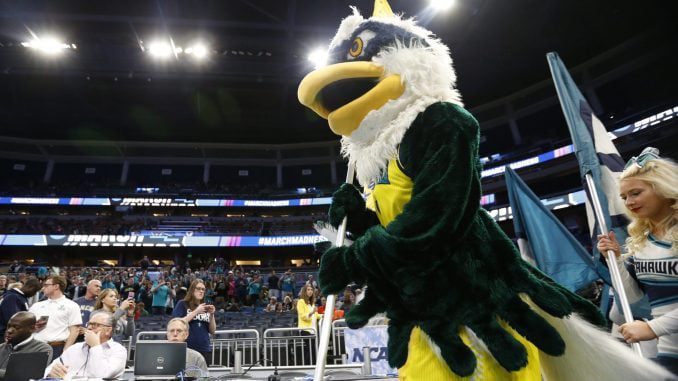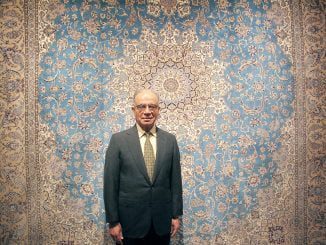
We’ve looked at Blue Devils, Demon Deacons, Fighting Camels and plenty of Bulldogs. We’ve seen a mascot almost kill a member of the opposing band and another mascot that liked to sleep in busy hallways on campus.
We conclude our trip through North Carolina to trace the origins of the nicknames for each of the state’s Division I college teams with a half-dozen schools across the east and Piedmont regions.

Elon Phoenix
Sportswriters have fallen in stature in recent years. While there’s nothing wrong with writing stories about the origins of team nicknames, a century ago, the sportswriters were the ones coming up with the nicknames.
We’ve already had a few teams whose nicknames derive from exuberant writers covering a big game — including the Wake Forest Demon Deacons and the Davidson Wildcats.
The roots of Elon’s nickname also can be traced back to a writer’s pen. In 1921, when Elon beat cross-town rival Guilford — whose sports teams went by the nickname Quakers — a sportswriter contrasted the two teams by referring to Elon as the Fightin’ Christians.
That name stuck for nearly 80 years. Over that time, Elon upgraded its level of competition from NAIA to Division II before finally beginning its transition to Division I play in the late 1990s. At the time, school officials thought that, perhaps, the school needed a new nickname that was better suited for its new Division I status.
In 2000, the school rebranded itself the Phoenix, referring to a major fire on campus in 1923 that destroyed buildings, classrooms, the library, chapel and student records.
“Like the legendary Phoenix, which rises from its own ashes with new life and vigor, Elon College was shaped by the fire, emerging as a stronger institution,” the school president proclaimed. “The elegant and brilliant Phoenix described by ancient scholars was sleek, swift and one-of-a-kind. I can think of no better description for Elon’s outstanding athletics programs.”
High Point Panthers
It’s tough for a school to differentiate itself when it has one of the most common mascots in the country. That’s the case with High Point, who chose the fourth most common nickname in college sports — the Panthers. A total of 33 teams in all divisions call themselves the Panthers, including eight Division I schools.
High Point has done its best to stand out, however, choosing a bright purple mascot named Prowler to represent it. Among other things Prowler has done is hold a press conference to talk about spirit initiatives at the school — which lasted about 30 seconds before the assembled reporters realized that he couldn’t speak.
NC A&T Aggies
A&T is another school that has a fairly common nickname. Like many agriculture schools — eight of them around the country — A&T adopted the nickname Aggies in 1891.
The school’s mascot, however, is a bulldog named Aggie Dog (or Dawg, depending on how cool you are). Legend has it, the choice dates back to early in the 20th century when a bulldog was used to help herd the school’s livestock.
During a football game, a bad call by an official wiped out an A&T touchdown and someone supposedly untied the dog and sic-ed it on the referee.
A&T wisely decided to get rid of live dogs on the sideline in 1984 and have had a two-legged, costumed version of Aggie Dawg ever since.
N.C. Central Eagles
Yet another North Carolina school that went with a common nickname. More colleges use Eagles than any other nickname, with 75 other schools sharing the moniker with Central. For 37 years, from the school’s beginning in 1910 until 1947, NCCU founder Dr. James E. Shepard gave the same speech to the student body to open the school year.
“The Eagle is no common, ordinary barnyard fowl,” he would say. “And while a sparrow clings to its flock, an Eagle soars alone.”
UNC Greensboro Spartans
UNCG got its nickname relatively late, which is due in large part to the history of the school. It began in 1891 as a women’s college (known for years simply as Women’s College). Since sports opportunities for women for much of the 20th century were, at best, limited, there was no need for a team nickname. The closest the school had to a mascot was Minerva, the goddess of Wisdom and Women’s Arts, whose head appears on every diploma the school has ever awarded.
Men were admitted for one year in the Great Depression and the resulting basketball team that was organized was known as the Tom Cats.
The school changed its name and began admitting men in 1964, and organized sports teams soon followed. The school’s athletic director chose Spartans, partly in keeping with the ancient tradition represented by Minerva (although she was a Roman goddess, while Spartans are from ancient Greece), and partly because he wanted “a name which had a masculine ring and a tradition of courage.”
Meanwhile, a statue of Minerva still stands outside the University Center.
UNC Wilmington Seahawks
Here’s another story where you’ll have to strap in. It has a few sharp twists and turns.
Wilmington is located close to the coast, so the nickname Seahawks seems fitting. However, the name was originally chosen as a way to pay tribute to … Iowa.
Yes, the landlocked state in the middle of the country, about as far from a sea as it’s possible to get. That Iowa.
During World War II, the Navy established pre-flight schools to train pilots at colleges around the country, including UNC, Georgia and the University of Iowa.
The Pre-Flight schools organized sports teams and competed against colleges. Iowa Pre-Flight chose the nickname Seahawks, which was fitting for aspiring Navy pilots, even those currently located in the heartland. They finished as high as No. 2 in the AP poll during the war and were one of the more popular football teams in the country.
When UNCW was looking for a nickname in 1947, its five-person committee decided to revive the nickname in the post-war era.



